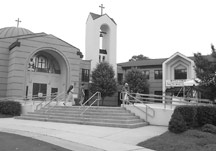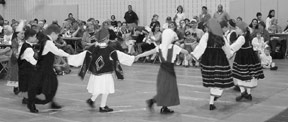|
Chesapeake Destinations
Annapolis Greek Festival
Culture, costumes, music and dancing attract many to the weekend bazaar. For others, the list of attractions starts with moussaka, proceeds to gyros, continues to calamari and concludes with dessert.
by Louise Vest
For a view of a spectacular sunset some people go down to the water. Others sit in the parking lot of the Greek Orthodox church on Riva Road. That’s where, on the front of Saints Constantine and Helen’s Church, a top-notch receiver reflects its glory. The 22-carat gold mosaic catches the sun’s last rays, magnifies them and then releases them to spectators in shimmering saffron and achingly intense amber.
“I’ll look out from my office window at sunset and see people sitting in their cars just looking at the mosaic,” said Kosmas Karazellas, priest at Saints Constantine and Helen.
The sunset view lures some in for a few minutes, but this weekend Greek culture decked out for company draws thousands for the Annapolis Greek Festival.
The culture, costumes, music and dancing — games for kids, and a tour — attract many to the weekend bazaar.
 For others, the list of attractions starts with moussaka, proceeds to gyros, continues to calamari and concludes with dessert: a mountain of golden pastry, honey dripping languidly down its flaky slopes. For others, the list of attractions starts with moussaka, proceeds to gyros, continues to calamari and concludes with dessert: a mountain of golden pastry, honey dripping languidly down its flaky slopes.
Orthodoxy and the Skins
Preparing the food, staffing the tables and running the children’s corner takes a contingent of volunteers. Saints Constantine and Helen has a pool to draw from with some 700 congregants, including a Sunday School with 225 children. People come from nine counties and three states for church services. It’s an ethnically eclectic group, as well: Russian, Serbian and Syrian and the Greeks as well as converts who are Irish, Scottish and German.
The congregation moved from D.C. in 1986. Ever-growing, they have not only a new church but also reach out to the University of Maryland where Karazellas has also been the chaplain to college’s approximately 800 Orthodox believers for 13 years.
In addition, the church also holds a monthly services in Southern Maryland at Holy Trinity Lutheran Church in Lexington Park for a congregation of about 70 families.
At the well-attended annual festival, volunteers from all these communities pile kiosks high with art and crafts, and there’s food for sale inside and outside the church. For al fresco dining, tables and chairs are set up under a tent on the grounds.
The profits from the festivals enrich the church’s general fund, which pays for everyday expenses and supports outreach missions in Kenya, India and Ugunda.
Spreading the word, Karazellas adds an introduction to the Orthodox faith to his tours of the church and its Byzantine architecture. The tour begins outside, where visitors learn that the mosaic’s theme is resurrection, that it is the only one of its kind in the world and took two and a half years to piece together. It is no accident that the mosaic blazes into an even more glorious sight at sunset, iconographer Leonidas Diamondopoulos planned it that way.
As the tour moves into the sanctuary, visitors sit in pews to learn the orthodox religion isn’t very different from other Christian religions, except that each service brings a cascade of tradition including incense, candles, bells, icons and vestments trimmed in gold. There’s even less difference between the Russian and Greek orthodox churches, except language. Today most orthodox churches hold their services in English, with some Greek.
“All our formality is the way we show respect and reverence,” said Karazellas. As he talks about the priests’ vestments, he holds up a gold and maroon one. “When the Red Skins are playing at home, I wear this one,” he says.
Kicking up Some Tradition
Throughout the festival, dance fever breaks out in the gym, where you can pull up a chair to watch children and adult troupes continue ancient dance traditions.
In one set, knots of young dancers unfurl and spread out over the floor. Moving to the music’s beat, they lock arms, hold hands in a line and weave in and out, the girls’ gold-edged orange scarves swaying wildly along, enjoying the ride. Their intricate moves and dance expertise turns the gangly-arms and knobby-knees age group into impressive entertainment.
 “It’s no jazzed up Greek dancing, it’s traditional folk dances,” Karazellas says, The church is so serious about getting it right that a professional trains the dancers. Every January, the church hosts a festival that brings Greek dancers from all over the East Coast. “It’s no jazzed up Greek dancing, it’s traditional folk dances,” Karazellas says, The church is so serious about getting it right that a professional trains the dancers. Every January, the church hosts a festival that brings Greek dancers from all over the East Coast.
With dance practices held every week, membership in the Aegean Odyssey Dancers, the child and adult dance group, is a serious commitment for both parish dancers and their parents. Some parents drive their kids an hour and a half each way to make practice.
“I got criticized about the dancing by clergy because they said Christ isn’t in the dancing. But when I see kids keeping busy, sharing, laughing, and learning, I believe Christ is there,” said Karazellas whose college-student daughter is a member of the Aegean adult dancers.
“I’m kind of controversial,” the priest confesses. “But you want to bring people in, so you have something to offer those people on the edges. And I know about not throwing stones. I’ve sinned and come back, sinned and come back. We Orthodox don’t look at sin as unforgivable. You grow in life through its ups and downs.”
Soul Food
Greek food is good for you, and we have the figures to prove it. That’s the legend that appears under pictures of robust statues on the festival brochures.
Like Italian food, Greek food can be different according to its origins, north, south or the islands. Karazellas says he “loves it all,” though he needs to approach eating diplomatically within church environs.
“The women of the church will watch to see what dish I don’t take, so I try to put a little of everything on my plate,” he says.
Food is a great draw for bringing people into the church. “My Baptist minister friends talk about stewardship, but we have our food, so why not use it? Everyone likes our food!”
But the festival, like the sunset, lasts only a short time.
“The festival is an exciting event, and fun,” says Karazellas. “But it’s just for a few days. For us, every day is joyful.”
11am-11pm June 4 & 5; 1-7pm June 6 @ Saints Constantine and Helen Greek Orthodox Church, Riva Rd., Annapolis. free: 410-573-2072 • www.toad.net/~sch/.
|


 For others, the list of attractions starts with moussaka, proceeds to gyros, continues to calamari and concludes with dessert: a mountain of golden pastry, honey dripping languidly down its flaky slopes.
For others, the list of attractions starts with moussaka, proceeds to gyros, continues to calamari and concludes with dessert: a mountain of golden pastry, honey dripping languidly down its flaky slopes. “It’s no jazzed up Greek dancing, it’s traditional folk dances,” Karazellas says, The church is so serious about getting it right that a professional trains the dancers. Every January, the church hosts a festival that brings Greek dancers from all over the East Coast.
“It’s no jazzed up Greek dancing, it’s traditional folk dances,” Karazellas says, The church is so serious about getting it right that a professional trains the dancers. Every January, the church hosts a festival that brings Greek dancers from all over the East Coast.